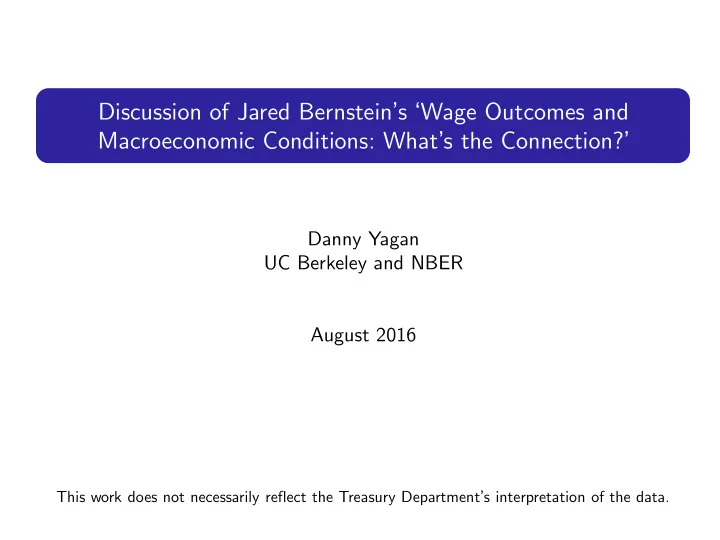

Discussion of Jared Bernstein ’ s ‘ Wage Outcomes and Macroeconomic Conditions: What ’ s the Connection? ’ Danny Yagan UC Berkeley and NBER August 2016 This work does not necessarily reflect the Treasury Department ’ s interpretation of the data.
Key issue: Efficiency of low employment and wages Three claims 1. Underemployment is the norm 2. Underemployment reduces wages 3. Optimal policy raises employment Do-Nothing response: Persistent employment losses are inevitable/efficient Maximizing employment rate does not maximize efficiency/welfare Policies raising employment may be redistributive but not efficient hard to agree on policy (and standard redistribution done via transfers) This discussion: Persistent employment losses not fully inevitable and possibly not fully efficient May broaden scope for policy agreement
Standard measure says full employment is restored Great Recession is over and we’re at full employment Source: Bernstein (2016)
But is the Great Recession really over? U.S. Employment 2007-Present Current rate minus Nov 2007 rate (pp) 4 Standard view: Yes… 2 0 -2 -4 2007 2008 2009 2010 2011 2012 2013 2014 2015 2016 …and nationwide Year skill-biased shocks U.S. unemployment rate (outsourcing, robots) caused inevitable U.S. labor force participation rate and efficient labor U.S. employment rate (employment-population ratio) force exit Source: Yagan (2016) “Is the Great Recession Really Over? Longitudinal Evidence of Enduring Employment Impacts”
Laboratory: Differently severe GRs across space Great Recession Local Shocks 2006-2009 local employment changes relative to 2000-2003 trend % Ex: -4% in Phoenix Ex: +1% in San Antonio
New evidence on lasting scars from Great Recession National Do-Nothing argument applies, if Phoenix skills simply obsolete Hold skill constant by comparing workers at same 2006 retail chain firm Phoenix San Antonio Assumption: As-good-as-random assignment conditional on 2006 retail firm and amount earned at 2006 retail firm E.g. Workers do same tasks across space and are paid their MPL
Longitudinal data Source: De-identified U.S. tax returns 1999-2014 Employed: Positive W2 wages or 1099MISC non-employee comp Location: 722 Commuting Zones (CZ ’ s) based on info return ZIP code [Tolbert-Sizer 1996; Dorn 2009; Autor-Dorn 2012; Chetty-Hendren-Kline-Saez 2014] Sample: 2,238,310 workers 25-75 working at 816 multi-CZ retail firms in 2006 who do not live in the CZ of the corporate headquarters CZ shock: 2007-2009 log-change in the CZ ’ s employment relative to trend
Effect of living in 2007 in a severely shocked CZ (pp) -1.5 -1 -.5 0 .5 1 1999 2000 2001 Employment Impacts of Great Recession Location 2002 2003 2004 2005 2006 Year 2007 2008 2009 2010 2011 2012 2013 2014
Effect of living in 2007 in a severely shocked CZ (pp) -1.5 -1 -.5 0 .5 1 1999 2000 2001 Employment Impacts of Great Recession Location 2002 2003 2004 2005 2006 Year 2007 2008 2009 2010 2011 2012 2013 2014
Effect of living in 2007 in a severely shocked CZ (pp) -1.5 -1 -.5 0 .5 1 1999 2000 2001 Employment Impacts of Great Recession Location 2002 2003 2004 2005 2006 Year 2007 2008 2009 2010 2011 2012 2013 2014 to continue, speed were attenuates in 2024. If latest impact
Effect of living in 2007 in a severely shocked CZ (pp) -1.5 -1 -.5 0 .5 1 1999 2000 2001 Employment Impacts of Great Recession Location 2002 2003 2004 2005 2006 Year 2007 2008 2009 2010 2011 2012 2013 2014
Heterogeneity in 2014 Employment Impact Subsample Overall Men Women Wages $1-$15k Causal increase in employment inequality Wages $15k-$45k across initial earnings (skill) level Wages $45k and over Age 45 and younger Age 46-61 Age 62 and older Single Married 0 kids 1 kid 2+ kids Non-mortgage-holder Mortgage holder -2.5 -2 -1.5 -1 -.5 0 .5 1 1.5 2 2.5 Estimated 2014 employment effect of great recession location (pp)
“ Full employment ” and efficiency Low employment after the Great Recession: not fully temporary, not fully inevitable, and possibly not fully efficient If workers scarred possibly more stimulus during recessions If places scarred possibly new stimulus now (e.g. mult. equilibria) Generally: Business cycle effects can last longer than typically measured, or else the ‘ cycle ’ is more than just a cycle around a fixed long-run trend and can affect the trend itself
Recommend
More recommend